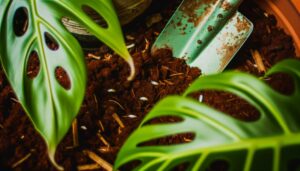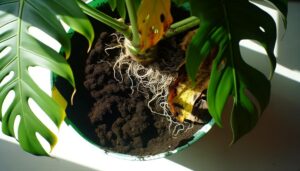Why Are My Monstera Leaves Turning Yellow? Common Causes!
Yellowing leaves on your Monstera can signify issues like overwatering or underwatering. Check soil moisture and confirm proper drainage.
Insufficient light and incorrect temperature can also cause this discoloration—aim for bright, indirect sunlight and keep temperatures between 65-85°F (18-29°C). Nutrient deficiencies, particularly in nitrogen, magnesium, and iron, can yellow leaves, so use a balanced fertilizer.
Be vigilant for pests like spider mites and aphids, and regularly inspect for infections. Maintain high humidity levels (60-80%) and guarantee your Monstera isn’t root-bound.
There are more strategies to explore for vibrant, healthy foliage.
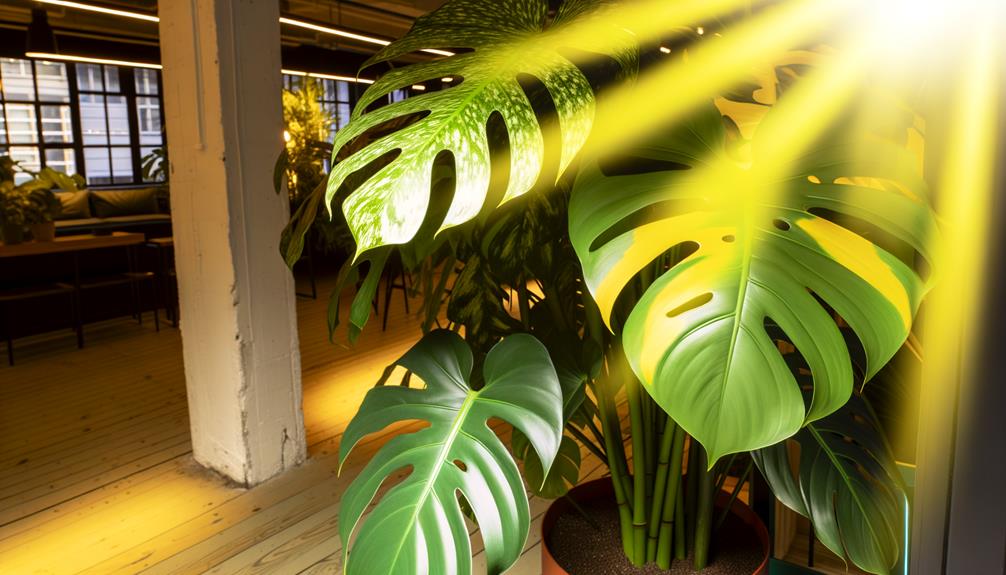
Key Takeaways
- Overwatering or underwatering can cause yellowing leaves; check soil moisture and adjust watering frequency.
- Insufficient light exposure leads to yellowing leaves; place in bright, indirect sunlight or use grow lights.
- Nutrient deficiencies, particularly nitrogen, magnesium, or iron, can cause yellowing; use balanced, water-soluble fertilizer.
- Pests and diseases stress plants, leading to yellowing; inspect regularly and implement pest control measures.
- Root constriction can cause yellowing leaves; repot into a larger container with well-draining soil.
Overwatering Issues
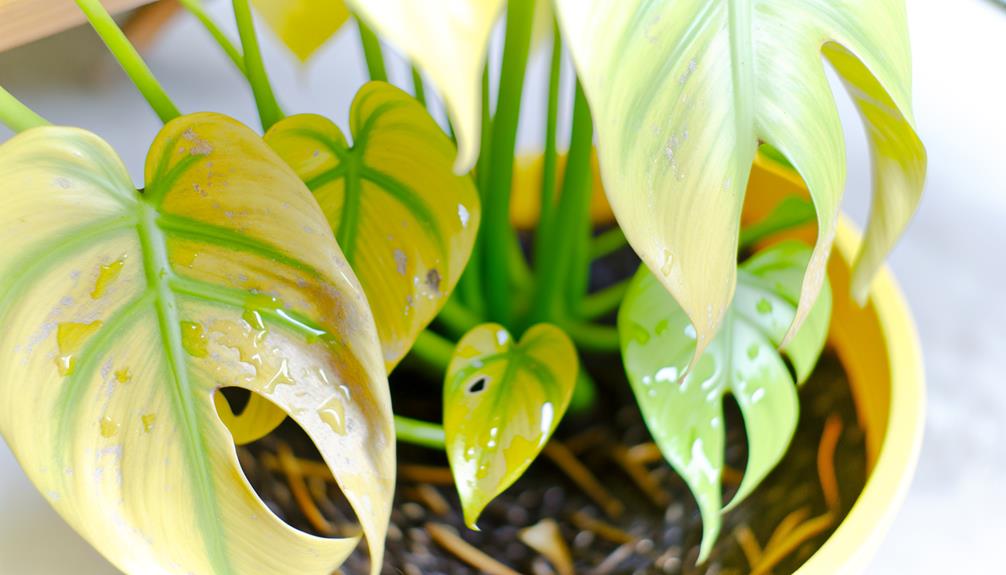
Overwatering is a primary cause of yellowing leaves in Monstera plants due to root oxygen deprivation and subsequent fungal infections. When you water excessively, the soil becomes waterlogged, reducing the oxygen available to the roots. This hypoxic condition stresses the plant, making it susceptible to root rot and pathogenic fungi.
You’ll notice yellowing leaves as the plant’s way of signaling distress. To prevent this, make sure your Monstera’s pot has adequate drainage holes. Also, allow the top inch of soil to dry out before watering again. Utilize a well-draining potting mix to facilitate proper aeration. Monitoring moisture levels with a soil moisture meter can provide further accuracy.
Underwatering Problems
You might notice your Monstera’s leaves turning yellow due to insufficient hydration, characterized by signs such as wilting and dry, brittle edges.
Regularly monitor soil moisture levels by inserting your finger an inch deep to validate the soil isn’t too dry. Adjust watering frequency based on environmental conditions, validating the plant receives consistent and adequate hydration.
Signs of Dehydration
A clear sign of dehydration in Monstera leaves is when they start to turn yellow, often accompanied by a dry, crispy texture. This indicates that the plant’s cells lack sufficient water, causing cellular structures to collapse.
Dehydration restricts nutrient transport, leading to chlorosis—the yellowing of leaves due to reduced chlorophyll. You might also notice leaf curling or browning at the edges.
To prevent further damage, examine the watering schedule and confirm the plant receives adequate moisture. Monitor your Monstera closely for these symptoms, and respond promptly to prevent irreversible harm.
Addressing dehydration early guarantees healthier growth and vibrant foliage, maintaining the plant’s overall aesthetic and physiological health.
Soil Moisture Levels
To better comprehend why Monstera leaves might be turning yellow due to dehydration, it’s crucial to examine soil moisture levels, as inadequate watering can greatly impact the plant’s health. When soil lacks sufficient moisture, it hinders nutrient uptake, resulting in chlorosis or yellowing leaves. Utilize a soil moisture gauge and monitor the moisture content regularly. Strive for consistent, even moisture without saturation.
| Measurement Tool | Optimum Reading | Action Required |
|---|---|---|
| Soil Moisture Gauge | 4-6 | Maintain current routine |
| Dry (below 4) | Below 4 | Increase watering |
| Wet (above 6) | Above 6 | Allow soil to dry out |
Monitoring guarantees you sustain ideal soil conditions, preventing dehydration-induced yellowing.
Watering Frequency Adjustment
Adjusting watering frequency is essential to address underwatering problems that lead to Monstera leaves turning yellow. Begin by evaluating the plant’s current hydration schedule.
Monstera plants typically require moderate watering; soil should remain consistently moist but not waterlogged. Utilize a moisture meter to accurately assess soil moisture levels, aiming for a reading in the mid-range. If the soil dries out too quickly, increase watering frequency incrementally, ensuring the soil has time to absorb water without becoming saturated.
Observe leaf condition and growth patterns as indicators of improved hydration. Additionally, consider environmental factors like humidity and temperature, as these can influence water needs. Implementing precise adjustments will mitigate underwatering and restore your Monstera’s vibrant foliage.
Inadequate Light
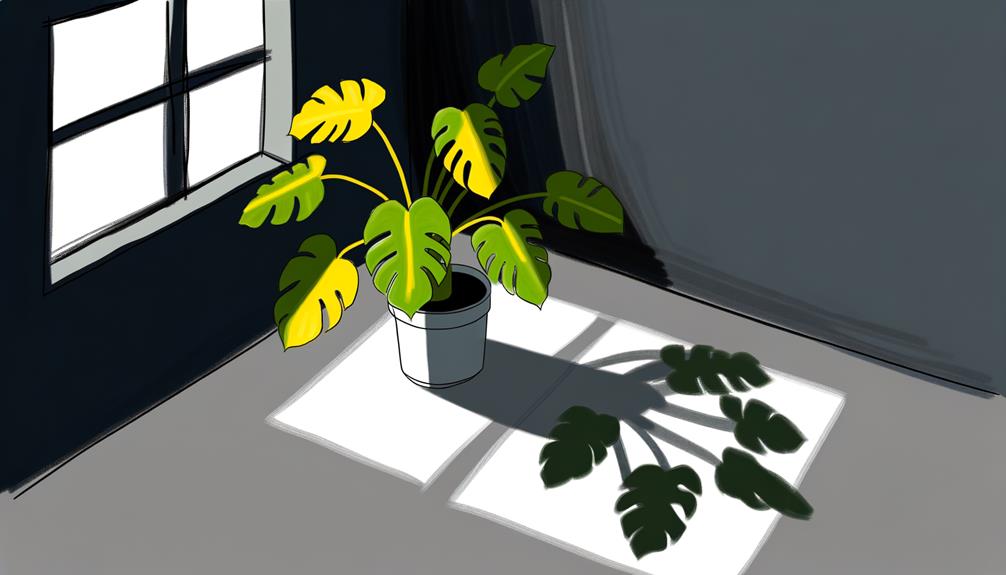
If your Monstera isn’t getting sufficient light, its leaves may start turning yellow due to inadequate photosynthesis.
Positioning the plant in a poorly lit area can worsen this problem, as it fails to obtain the required light spectrum for healthy growth.
Make sure your Monstera is placed in a spot with bright, indirect sunlight to alleviate this issue.
Insufficient Sunlight Exposure
Inadequate light exposure often leads to chlorosis in Monstera leaves, causing them to turn yellow. When your Monstera doesn’t receive enough sunlight, its chlorophyll production diminishes, leading to leaf discoloration.
To address this issue, consider the following:
- Check light levels: Make sure your Monstera is getting bright, indirect sunlight for best growth.
- Monitor leaf color: Yellowing leaves can indicate insufficient light; observe changes in leaf pigmentation.
- Adjust positioning: Place your plant near an east or west-facing window to maximize light exposure.
- Supplement with artificial light: If natural light is limited, use grow lights to meet your plant’s light requirements.
Poor Light Placement
Poor light placement can exacerbate issues of inadequate light, directly impacting your Monstera’s ability to photosynthesize effectively. When your plant is not situated in an optimal location, it can’t absorb sufficient light, leading to chlorosis (yellowing of leaves). Ensure your Monstera receives bright, indirect light for at least six hours daily.
| Light Condition | Impact on Monstera |
|---|---|
| Direct sunlight | Leaf burn, stress |
| Indirect bright light | Optimal growth, vibrant leaves |
| Low light | Yellowing, stunted growth |
| Artificial light | Supplementary but insufficient |
Temperature Stress
Temperature stress often leads to the degradation of chlorophyll in Monstera leaves, resulting in yellowing. This deterioration occurs when the plant is exposed to temperatures outside its ideal range, typically between 65-85°F (18-29°C).
Extreme temperatures can disrupt cellular processes, causing:
- Chlorophyll breakdown: Decreased pigment production impacts photosynthesis.
- Stomatal malfunction: Pores in leaves may not effectively regulate gas exchange.
- Water stress: High temperatures increase transpiration, leading to dehydration.
- Cold shock: Low temperatures can induce cellular damage and metabolic slowdown.
To enhance the indoor climate, monitor it using a dependable thermometer. Ensure your Monstera is positioned away from drafty windows, heating vents, and direct sunlight. Adjust your surroundings as needed to maintain consistent conditions, supporting healthy, green foliage.
Nutrient Deficiencies
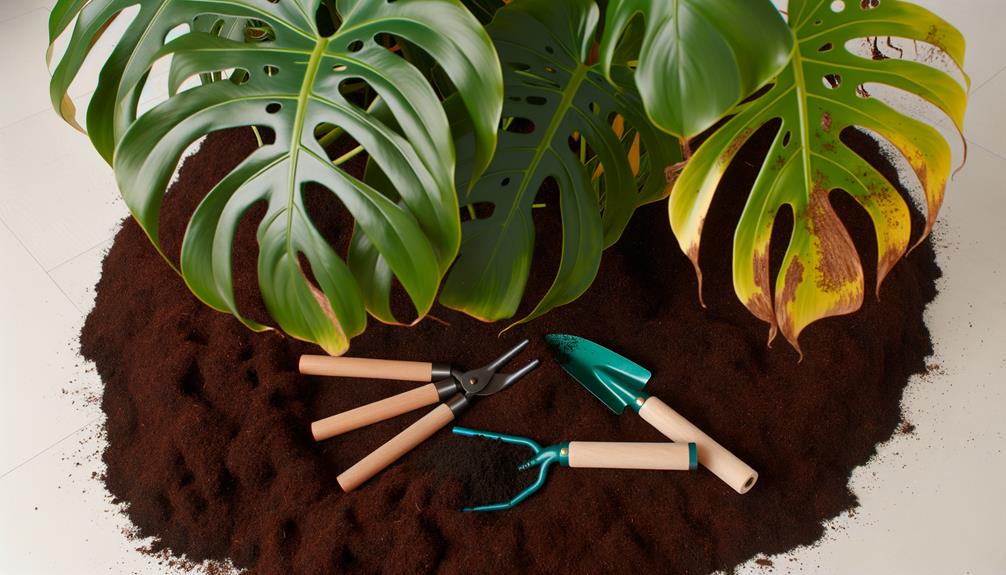
Nutrient insufficiencies, particularly a scarcity of crucial minerals like nitrogen, magnesium, and iron, can cause Monstera leaves to turn yellow by impairing chlorophyll synthesis and overall plant health.
When nitrogen is lacking, the older leaves often yellow first, as nitrogen is mobile within the plant and gets redirected to newer growth.
Magnesium insufficiency typically results in interveinal chlorosis, where the veins remain green while the leaf tissue turns yellow.
Iron insufficiency, more common in alkaline soil, causes young leaves to yellow while retaining green veins.
To address these deficiencies, use a balanced, water-soluble fertilizer rich in these essential nutrients. Regularly test your soil’s pH and nutrient content to guarantee optimal growing conditions for your Monstera.
Pests and Diseases
While addressing nutrient deficiencies is essential for healthy Monstera leaves, it’s equally important to recognize that pests and diseases can also lead to yellowing foliage.
Common pests like spider mites, aphids, and scale insects feed on the plant’s sap, causing stress and discoloration. Bacterial and fungal infections, such as leaf spot and root rot, also impair nutrient uptake and lead to yellowing.
To manage these issues, consider the following:
- Inspect leaves regularly: Look for signs of pests or infections.
- Maintain proper humidity: High humidity can deter some pests.
- Use insecticidal soap: Effective against common pests.
- Isolate affected plants: Prevents the spread of diseases.
Poor Soil Quality
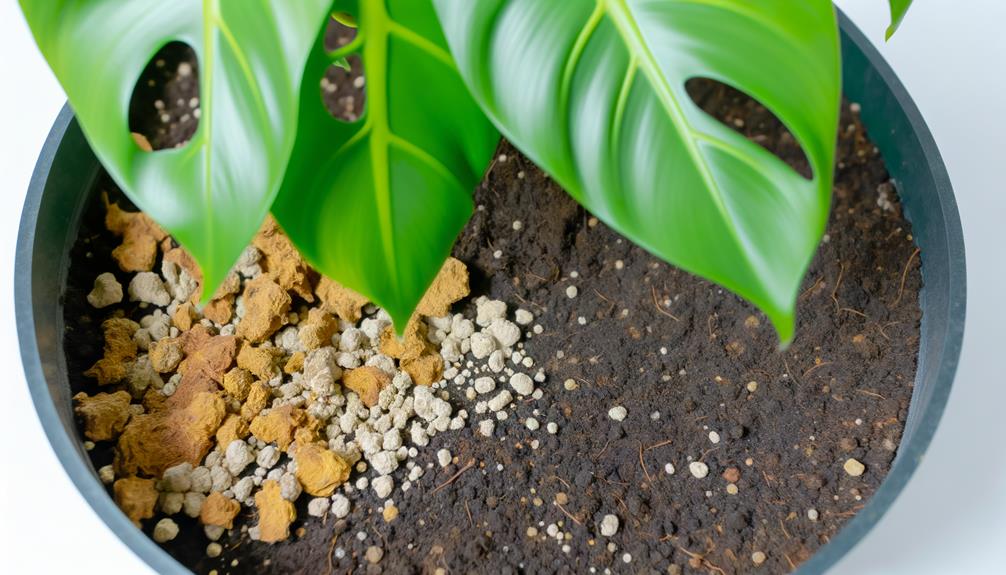
Compromised soil health can impede Monstera growth, leading to yellowing leaves caused by poor nutrient availability and improper drainage. Your Monstera needs a well-draining, nutrient-rich soil mix to thrive.
If the soil becomes compacted or overly dense, root aeration diminishes, causing water retention issues and root rot. Ensure your potting mix includes components like perlite, peat moss, and orchid bark to enhance aeration and drainage.
Regularly check soil pH, as an imbalance can limit nutrient uptake. Aim for a pH between 5.5 and 7.0. Additionally, periodic soil amendments with organic matter can replenish essential nutrients.
Humidity Levels
In addition to maintaining ideal soil conditions, ensuring sufficient humidity levels is essential for preventing yellowing leaves in your Monstera.
These tropical plants thrive in humid environments, typically preferring humidity levels between 60-80%. Inadequate humidity can lead to leaf desiccation and chlorosis.
To maintain best humidity, consider the following methods:
- Humidifier: Use a humidifier to consistently maintain the desired humidity range.
- Pebble Tray: Place a tray filled with water and pebbles beneath the plant pot to boost local humidity.
- Misting: Regularly mist the leaves with distilled water to simulate their natural habitat.
- Grouping Plants: Cluster multiple plants together to create a micro-environment with higher humidity.
Root Bound Conditions
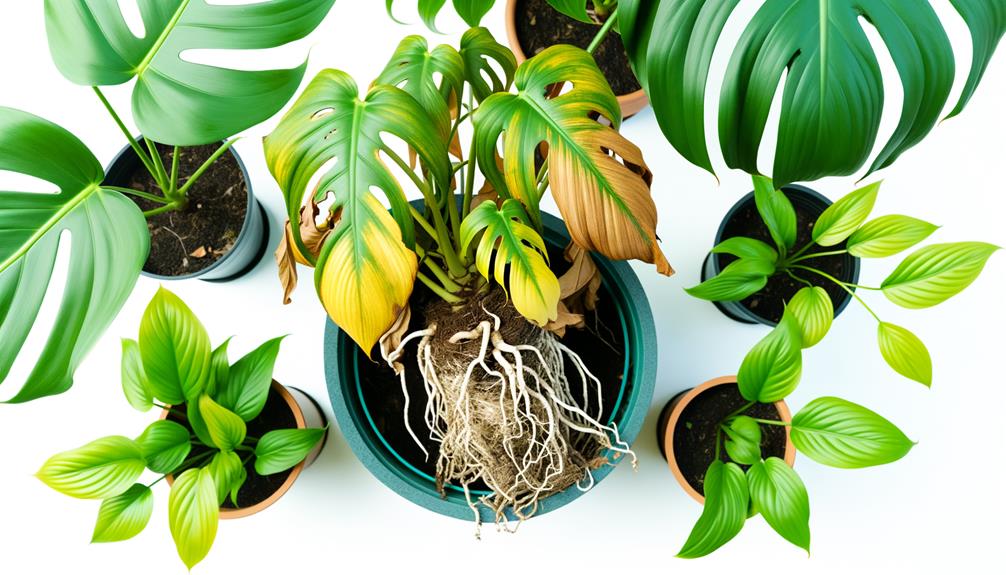
When your Monstera becomes root constricted, its roots have outgrown the pot, leading to restricted nutrient uptake and potentially causing the leaves to turn yellow. This condition limits the root system’s ability to absorb water and essential minerals efficiently.
You might notice tightly packed roots circling the pot’s interior, a clear indicator of root constricted conditions. To address this, carefully repot your Monstera into a container 2-4 inches larger in diameter. Use a well-draining soil mix to enhance aeration and prevent waterlogging.
Pruning some of the roots can also stimulate healthier growth. Regularly inspect the roots to avoid recurrence. By maintaining peak root health, you optimize your Monstera’s foliage remains vibrant and free from yellowing.
Monstera Root Bound Yellow Leaves
Yellow leaves on a Monstera plant can be a sign of it being root bound. When a Monstera becomes root bound, its roots outgrow the pot and become compacted, which prevents them from absorbing water and nutrients effectively. This can lead to yellowing leaves and overall poor plant health.
Symptoms of a Root Bound Monstera:
- Yellowing Leaves: Particularly the lower leaves, which may also develop brown or black spots if the issue persists.
- Dry Soil Despite Watering: The soil may appear dry even after watering, or water may pool on the surface.
- Roots Growing Out of the Pot: Roots may be visible growing out of the drainage holes at the bottom of the pot.
Solutions:
- Repotting: Move the Monstera to a larger pot to give the roots more space to grow. Use fresh, well-draining soil.
- Root Pruning: If the roots are severely compacted, gently tease them apart or trim them to encourage new growth.
- Regular Maintenance: Repot the plant semi-regularly to prevent it from becoming root bound again.
Addressing the root bound issue can help restore the plant’s health and prevent further yellowing of the leaves.
Conclusion
So, why are your Monstera leaves turning yellow?
It could be due to overwatering, underwatering, inadequate light, temperature stress, nutrient deficiencies, pests, poor soil quality, humidity levels, or root-bound conditions.
Assess each factor carefully; your plant’s health depends on it.
Are you providing the best environment for your Monstera to thrive?
By addressing these issues, you’ll promote strong growth and vibrant foliage.
Remember, attentive care leads to a lush, healthy plant.

